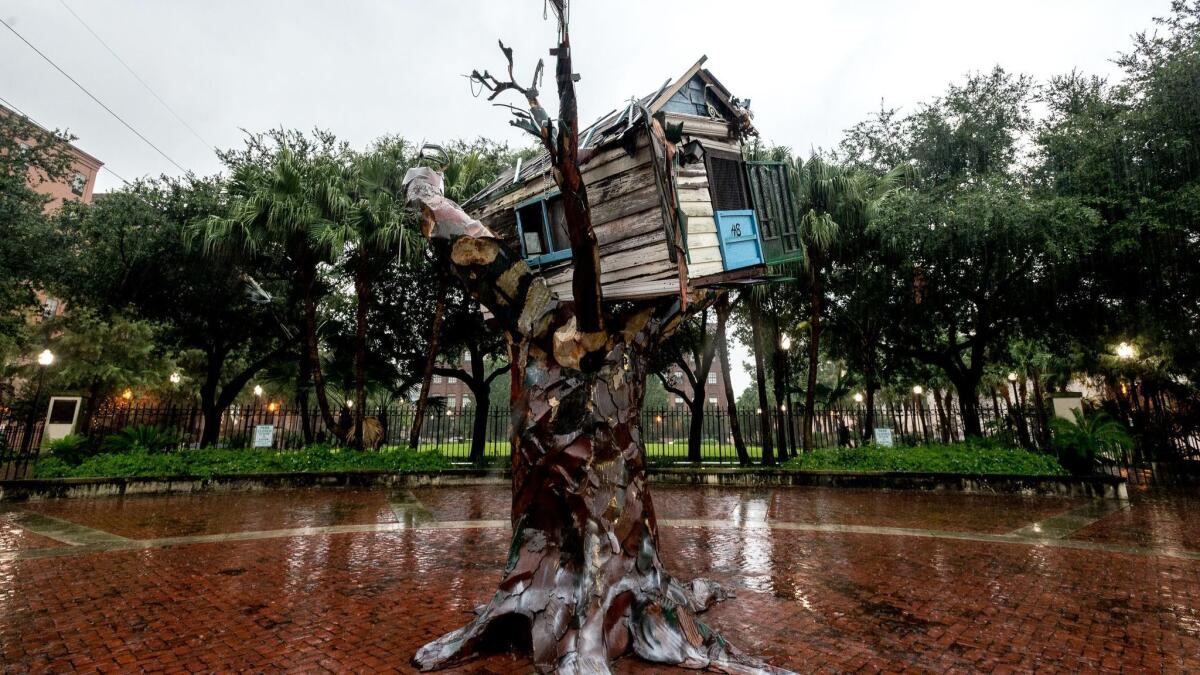Like New Orleans after Katrina, Houston faces heartbreak, resilience and recovery following Harvey

New Orleans is bracing itself for Tropical Storm Harvey but residents know the drill. (Aug. 30, 2017) (Sign up for our free video newsletter here http://bit.ly/2n6VKPR)
- Share via
Twelve years to the day after Hurricane Katrina made landfall in southeastern Louisiana, residents of New Orleans braced themselves Tuesday as Tropical Storm Harvey threatened to unleash its fury on the city.
With memories of Katrina still enduring — the 1,500 people killed in Louisiana, the 200,000 structures damaged — there was widespread worry that Harvey’s strong rains could lead to another sad and saturated saga. A heavy storm already overwhelmed New Orleans’ flawed pumping system in early August, causing many of the city’s streets to flood.
But New Orleans residents know the drill. Katrina forced them to develop a tacit skill-set that has allowed them to pick up, recover and move on. Houstonians could learn from this.
When the rain stops, the skies clear and world’s media turns its focus elsewhere, New Orleanians know what awaits Houston. There will be hardship and heartbreak, rejection and resignation, resilience and — if New Orleans is a guide — revival.

I witnessed this as a correspondent based in New Orleans for 14 months covering the rebuilding of the city after Katrina.
For months, after what became known simply as “the storm,” the power supply would be zero or sporadic in many neighborhoods. Certain areas remained without potable water for weeks or under a boil-water alert.
Basic conveniences disappeared. There was no regular mail delivery. Local supermarkets, mom-and-pop corner stores, banks, churches and schools remained shuttered for weeks, if not months.
Shards of glass, metal debris and nails peppered neighborhood streets, making driving a feat of precision navigation. Hundreds of discarded flat tires piled up under bridges and freeway underpasses.
For weeks, the rancid smell of mold and sewage — and death — hung in the air in certain enclaves. It seemed to cling to clothes, penetrate the pores and linger on the lips.
Resignation set in as residents realized they probably would never be able to reclaim what they once had. Anger and frustration erupted over the lethargic pace of New Orleans’ recovery and authorities’ failure to deliver promised assistance. Federal, state and city officials played the blame game.
Thousands of mobile homes, meant to provide temporary housing for those made homeless, ended up stockpiled in Arkansas because of a bureaucratic hiccup. Houston will need thousands of shelters for its internally displaced.
The slow pace of payouts provided through the “Road Home” program — government grants to renovate and rebuild storm-damaged homes — also began to wear on victims of the storm.
Stress led to weight gain. Residents would both joke about, and lament, having gained the “Katrina 15.”
Then came “Katrina cough.” A large number of people along the Louisiana and Mississippi coasts developed a condition that caused a sore throat, itchy eyes and other flu-like symptoms. Some doctors believed the allergies were linked to the mold and dust that permeated the atmosphere.
A year after Katrina, many hospitals in the New Orleans area remained closed. Medical specialists were among the waves of residents who evacuated the city, and many never returned. A dearth of practitioners, such as counselors, led to friends and family becoming each other’s go-to therapists. People just needed to talk it out.
Just saying “Katrina” seemed painful; it was reduced to the “K-word.” The K-word always came up in conversation, no matter the topic. Tears typically accompanied talk.

But the storm did not only spawn hardship and discontent. It seeded solidarity. Neighbors created cleanup brigades. Some businesses offered discount construction supplies; some restaurants provided free meals. Many New Orleans expats returned to help rebuild their hometown.
Katrina also meant an opportunity to start over and make some much-needed change. Onetime gritty and unattractive older neighborhoods got a face-lift. Critics of New Orleans’ notoriously negligent indigent defense system saw an opportunity to push for reform after Katrina exposed that an untold number of people arrested shortly before the storm had been left to languish behind bars without their day in court.
And local activists seized the moment to try to revamp the city’s failing public school system by leading a drive to attract new teachers and principals and pushing for shoddy school buildings to suitably restored.
Examples of goodwill, unity and perseverance are already prevalent in Houston. Scores of volunteers have used their private boats to run rescue missions. Churches, mosques and synagogues have opened their doors to those in need — regardless of faith. Television reports and social media are awash with images of strangers helping and hugging one another.
These images, along with vast stretches of dilapidated structures and muddy water, also brought to mind the New Orleans I lived in after the storm.
Houston Mayor Sylvester Turner has been resolute about the future of his city.
“This storm will not break our spirit,” he tweeted Monday. “We are in this together and we will rebuild even greater together after #HurricaneHarvey.”
Ray Nagin, then mayor of New Orleans, had said as much. As the second anniversary of Hurricane Katrina neared, Nagin was adamant that the Crescent City would rise again.
“New Orleans is coming back,” he told constituents, “whether you like it or not.”
For more on global development news, see our Global Development Watch page, and follow me @AMSimmons1 on Twitter
ALSO
On the road in Texas, where all the roads look like rivers
A Houston family taking refuge on a roof watched as bodies floated by
More to Read
Sign up for Essential California
The most important California stories and recommendations in your inbox every morning.
You may occasionally receive promotional content from the Los Angeles Times.










